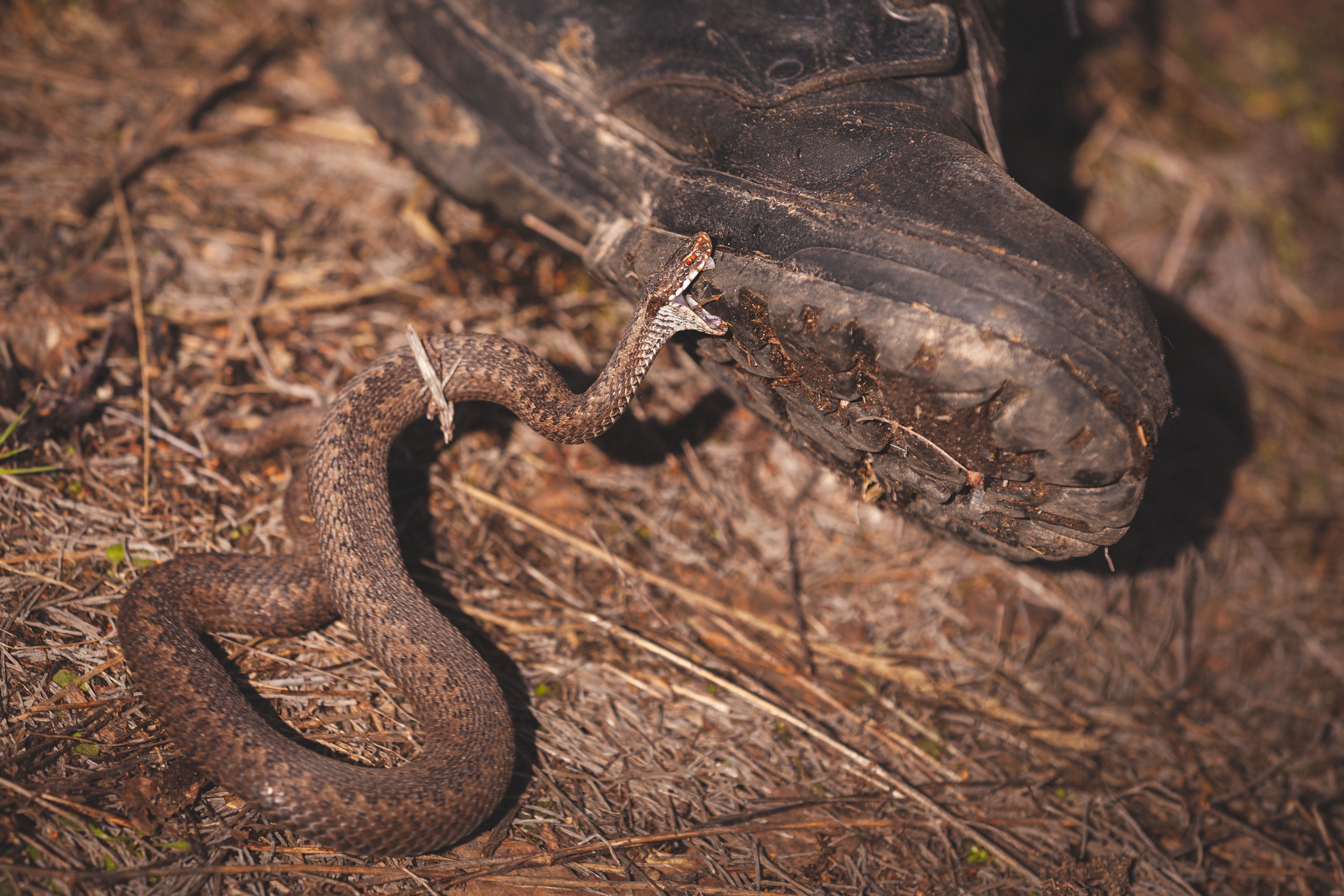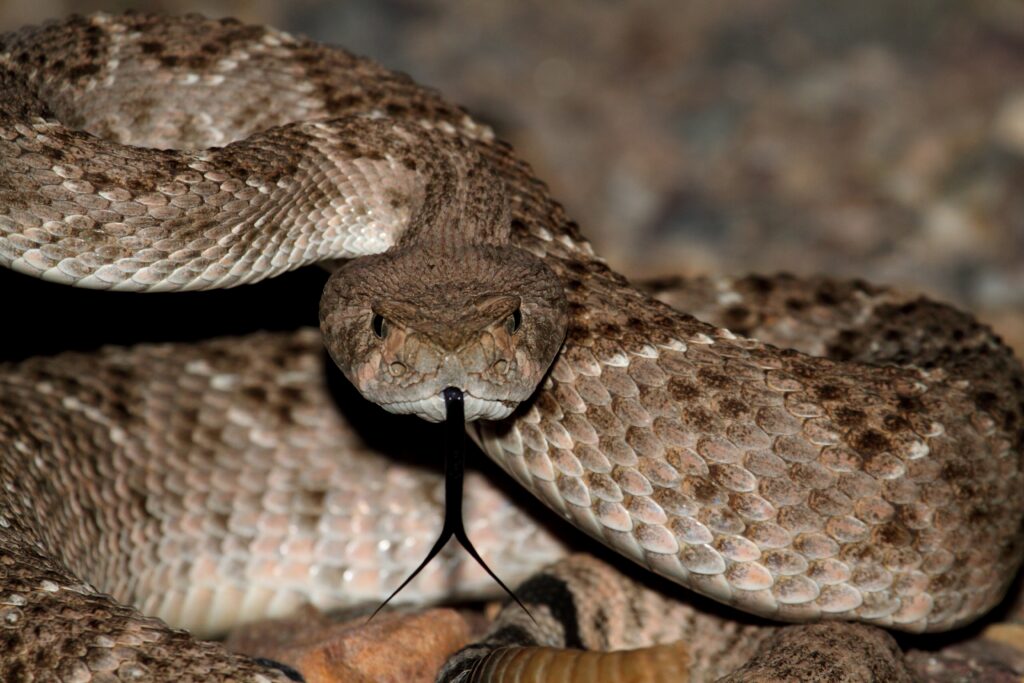Cowboys and workers often work in rural areas where rattlesnakes could be present. Luckily, those people also are likely to be wearing thick leather boots of some kind. But is that enough protection? Can a rattlesnake bite through leather boots?
Many types of heavy-duty tall leather boots are resistant to rattlesnake bites. But it will be best to buy a pair of boots designed and labeled as snake boots to be certain that can withstand a rattlesnake bite.
When you work or walk around areas that contain any species of biting snake, it is recommended to wear the proper equipment to protect yourself and the serpents. A good defense is the best offense when it comes to rattlesnakes.

The Best Boots to Wear to Defend Rattlesnake bites
When choosing what shoes to wear around snakes, there are a few points that you should consider:
- Shoe height
- Durability/longevity
- Comfort
When you’re working around snakes, you will need shoes that come up high on your legs to protect you from bites that are aimed higher up. Mostly, if the boots come up to your mid-calf or the bottom of your knee, then you should be fine.
Adding a pair of sturdy, loose-fitting pants will also provide extra protection.
Durability and longevity are pretty obvious—you need these boots to be strong and last for a while. As long as you invest in a high-quality boot, such as real cured leather shoes from a trusted business, then they will usually work well and last a long time.
Finally, you should consider comfort.
This is especially important if you know that you are going to be wearing these shoes for long periods of time without breaks. It must be noted that it is common for shoes that are built specifically for snake bites to be hot and sweaty.
But, that does not mean that they will be totally uncomfortable. Look for boots that have some kind of padding inside.
Some of the best shoes include the Thorogood Men’s Snake Boots from Amazon, which are a good choice based on the criteria above. They even ranked high in this Shoe Guide article written about snake boots.
Not only do these boots protect you against snake bites, but they are also waterproof and camouflaged for those who are seeking out these dangerous serpents.
Another plus about these shoes is that they have slip-proof rubber soles which make them much safer to walk around in. These are not the cheapest option, but they will protect you as you work, so the investment is worth it.
Brandon Harmon from Rattlesnake Solutions LLC (an excellent snake control company in Arizona) states that their workers wear these turtle skin Gator brand boots from Amazon.
These are professional, snake-specific boots that protect all the way up to the mid to upper shin area.
While they are not made of leather, they are made from a “super-tight patented weave of high-strength ballistic fibers and polyester,” which will work well for snake defense.
They also claim that they feel cool on the inside instead of feeling insulated, which is hard to do with snake boots. These are the most affordable shoes on this list, but they are still an excellent choice for anyone trying to protect themselves from snakes.
A worker from the Superstition Serpentarium (a reptile center located in Youngberg, Arizona) recommends the leather snake boots from Danner.
This website has plenty of options for snake-proof boots and the Pronghorn Snake Boots seem to be one of their best. These are the most expensive shoe option in this article. are currently priced at $310, but they have some nice features.
They are breathable, waterproof, and have gripping tread on the soles.
What to do when Encountering a Rattlesnake
The Washington Trail Association has stated that the three things you need to do when you find a rattlesnake on your trail are to, “freeze, listen, and slowly retreat.”
These three things can keep you safe and the rattlesnake calm when you accidentally intrude on the serpent’s territory.
Freeze and stop in your tracks immediately
Even if you just hear a rattle but do not see a snake, just freeze and assess your surroundings for a second before moving forward. You could be heading right for one and not even notice.
If you do notice it, freeze and do not make any sudden, threatening movements.
Remember, rattlesnakes are not vicious and will usually leave you alone as long as they feel safe. Sudden movements could frighten the creature and cause it to lash out and strike you. Just freeze, take a deep breath, and stay calm.
Listen to locate the sound of the supposed rattle
If you cannot see a snake, it is imperative that you can make sure you know exactly where it is so you do not accidentally step right onto it.
Slowly move your head and scan all of the ground in front of you, and if you still cannot see it, calmly but cautiously turn your body and scan the ground behind you.
Only after you can visually see the snake should you move on to the next step.
The final step is retreating
Once you find the serpent in your area, you must slowly back away while facing the snake.
It will be difficult to not run away, but as long as you keep your cool as you leave, the snake will feel less inclined to attack or follow you out of the vicinity.
Watch the snake as you back away, then, once you feel like you are at a safe distance, contact your local wildlife rangers or snake sanctuary so they can notify others or get the rattlesnake to a more secluded area.
The United States Department of Agriculture (USDA) has compiled a document all about rattlesnake safety and how to prevent an encounter.
The best practices to keep in mind are to watch the ground, avoid tall grass or crevices, and wear thick shoes and long pants.
Watching the ground can often be difficult when you are walking through beautiful areas, but you should be watching your step. If you know it will be difficult for you to keep your eye on the ground, then go on a trail that is frequently used by people.
Rattlesnakes will avoid areas that are frequently used by crowds of people.
During the day, rattlesnakes will often hide in tall grass, and at night, they will return to their dens to rest (which are often located in crevices or under rocks). Avoid walking through, stepping in, or blindly feeling around in areas like these.
There could be a snake taking a nap there and you would not even notice it.
Of course, even when you take all these precautions, you cannot be expected to be totally vigilant at all times. This is why wearing the correct gear is so crucial.
Not only should you choose your boots correctly, but your socks and pants as well. Wearing thick socks will give you an extra layer of protection if your shoes are not tough enough. The same is true with your pants.
Wearing long pants will aid in stopping a bite. Even if they are just a pair of jeans, these could be the final defense against a bite.
What to Do if Bitten by a Rattlesnake

Even after all the precautions, if you frequent an area with venomous snakes, it is still possible to get bitten. You could do everything right and still run into a rattlesnake that is having a bad day.
If you are bitten, there are steps you will need to take to slow the venom enough for help to get to you.
- Leave the situation calmly. If you notice that the bite is not affecting you as badly as typically described, then you should back away from the snake and get to a safe distance from the snake.
- Sit down and rest the area that was bitten. Do this once you are at a safe distance from the rattlesnake or have the full, painful symptoms. Stay calm and keep your heart rate low to slow the venom’s progression. When you rest the bite area, keep it at a lower than your heart if you can. For example, if you were bitten on the hand, sit down and lay your arm on the ground, and do not elevate it. This will give you some extra time before the venom reaches your heart.
- Call for help if you can. You should call 911 as soon as you can or if you see the symptoms appearing more severe. If you can, let them know what species you were bitten by. If you do not know immediately, do not go back and check or try to kill the snake. You would just be putting yourself in unnecessary danger.
- Remove any jewelry or items around the affected area. The bite area will swell and if you are wearing anything around it, it could cut off circulation on your body or make the venom travel faster through the body because of the added pressure.
- Clean the infected area. If you have soap and water or hand sanitizer, use it to disinfect the wound and keep it clean. If you have a clean cloth, you can lightly tie it around the bite to cover it from the air, but do not tie it tight. Do not put pressure on this wound or it will accelerate the blood flow and make the venom travel faster through you.
Source: Urgent Specialists
Rattlesnake Bite Symptoms:
If you are bitten by a rattlesnake, you may experience the following symptoms:
- Numbness in the face or limbs
- Lightheadedness
- Weakness
- Nausea or vomiting
- Sweating
- Salivating
- Blurred vision
- Difficulty breathing
The severity of these symptoms can differ depending on the species of rattlesnake and the amount of venom the snake injected into your system.
Symptoms can be milder, harsher, or even nonexistent, but each bite should be treated the same just in case. Even if you feel fine, you should call 911 and have them check you out to make sure there is no venom in your body.
If your symptoms are severe, try to stay alert and keep your eyes open.
It will be really difficult, especially if you are experiencing a lot of pain, try to stay calm and alert to survive and to keep an eye out for the snake.
Most Common Rattlesnakes

There are approximately 33 different species of rattlesnakes.
According to Britannica, in North America, the most common species are the eastern and western diamondback, the timber rattlesnake, and the prairie rattlesnake. The eastern and western diamondbacks are usually found in the eastern states, like Georgia, North Carolina, and Florida.
These are somewhat territorial and very venomous rattlesnakes, so make sure to keep your distance.
The timber rattlesnakes actually prefer forests, so the Smithsonian’s National Zoo and Conservation Biology Institute states that they are commonly found anywhere from eastern Canada to northern Florida.
Finally, the prairie rattlesnake controls the west side of the states.
Nature Conservancy mentioned that they frequent anywhere from western Canada all the way down the west to Texas. The states that they are most commonly found in are the northwestern areas like Idaho, Montana, and Utah.
These snakes are also all over the Rocky Mountains, so if you ever plan a trip to hike through these beautiful trails, remember to prepare accordingly to keep yourself and the creatures that inhabit the mountains, even these rattlesnakes, safe.
And on the West Coast of the US, the most common rattler is Crotalus oreganus (often called the Western Rattlesnake).
Most Common Rattlesnake Areas/Habitats:
Rattlesnakes frequent warm, dry climates.
They can be found in areas that are considered more desert-like, with lots of rocks, grass, mice, and small rodents. Luckily, rattlesnakes avoid largely urban places, but that does not mean that cities and popular hiking trails are devoid of serpents.
In the United States, the highest numbers of rattlesnakes live in:
- Texas
- Arizona
- New Mexico
- Wyoming
- Montana
- Utah
This is because they most closely match this climate description. They are also frequently found in the northern areas of Mexico.
Source: Britannica
Of course, I have to point out that I am not a doctor and I do not provide medical advice. I have years of experience in being around rattlesnakes, handling rattlesnakes, and removing them. But I have not been bitten, although I know people who have. You should not take my article as medical advice and if you need medical advice, and especially if you or someone you know has been bitten by a snake, you should immediately call 911 and seek out qualified medical assistance as quickly as possible.
As an Amazon Associate I may earn a small comission from qualifying purchases if you click to Amazon from my site and choose to make a purchase. You can read my complete affiliate disclosure for more details.
